The Orishas are Olodumare’s eldest children and have been imbued with a portion of Her aché. They have been tasked with maintaining this Earth, watching over the affairs of humanity and each has dominion over a portion of nature. They are more akin to demi-Gods in the religion of Santería. Because Olodumare has moved on to create other universes, we do honor and praise Her but focus our worship around the Orishas and our relationship with them.
Prior to the slave trade, each major city in Yoruba land was a center of worship for a different Orisha. When the slaves were intermixed and forced to coexist outside of their homelands, the worship of these Orishas became blended as well, and their worship of multiple Orishas became the standard practice within Santería (La Regla Lucumí). As an evolution of our initiation ceremony, within Lucumí practice, new initiates are ordained into the sects of multiple orishas instead of just one as was done in Africa. Every person ordained as a priest or priestess receives the mysteries of Elegguá, Obatalá, Oshún, Yemayá and Changó when they are crowned. If their tutelary Orisha is a different one than those five, they will receive that Orisha as well (Aggayú or Oyá for example). While they do receive the mysteries of multiple Orishas, they are crowned with only their tutelary Orisha and act as a living representative of that Orisha‘s energy walking amongst us all.
Below is a list of the most commonly worshipped Orishas within Santería. Each Orisha has its sacred number and colors, and we’ve also taken the liberty of indicating which Catholic saint is most commonly syncretized with that Orisha.
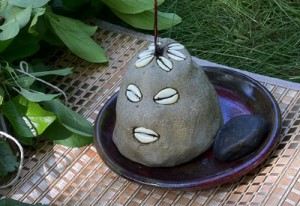
Elegguá is the owner of the crossroads and the most important Orisha in Santeria
Orisha: Elegguá (Elewá, Elegbá)
Saint: Saint Anthony
Colors: Red and black
Number: 3 and 21
Description: Elegguá is the first and most important Orisha in Santería. He is the owner of the crossroads, the witness of fate and acts as the connecting agent in this world. Elegguá is often perceived as a trickster or impish child who tests our integrity.
Orisha: Ogún (Oggún)
Saint: Saint Peter
Colors: Green and black
Number: 3
Description: Ogún is a mighty warrior, the divine blacksmith who crafts tools and weapons and the hardest working Orisha of them all. Ogún is the father of technology, the cutting edge of the knife and the power of metal. Ogún is often perceived as a powerful muscular man wearing a skirt made of palm fiber and he carries a machete.
Orisha: Ochosi (Ochossi, Oshosi)
Saint: Saint Norbert
Colors: Blue and amber
Number: 3, 7
Description: Ochosi is the divine hunter whose arrow never misses its mark. He stalks silently through the forest hunting his pray. He is the force of blind justice that is applied equally to all. He is best friends with Elegguá and Ogún and is often found hunting with them.
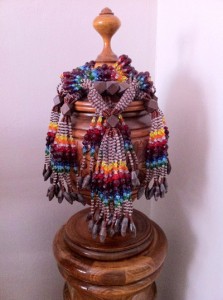
Aggayu’s shrine at our church.
Orisha: Orisha Oko (Orichaoco)
Saint: Saint Isidore
Colors: Light blue and pink
Number: 7
Description: Orisha Oko is the Orisha of agriculture and the fertile earth. He rules the mystery of the black earth that gives birth to crops and life, fertility and procreation. He is often depicted as a hard working farmer who wears a straw hat and plows the earth with a team of two oxen.
Orisha: Olokun
Saint: None
Colors: dark blue with green
Number: 9
Description: Olokun is the Orisha that rules the depths of the sea where light does not touch. He is a mysterious Orisha and there is some debate about whether Olokun is male or female. He is a primordial orisha arising out of his own ashé as the first oceans formed on the surface of the earth. He gathers the sunken treasures and souls of the drowned and rules from the depths. He is usually not depicted in a human form.
Orisha: Babalú Ayé (Babaluaye, Asojano)
Saint: Saint Lazarus
Colors: White, blue, brown, black
Number: 17
Description: Babalú Ayé is one of the most beloved, worshipped and petitioned Orishas in our religion. He is the Orisha of small pox, contagious diseases and of healing. In many ways he has become the modern day patron of HIV/AIDS and other epidemics. His worship is shared with the Arará people of Africa. Babalú Ayé’s name was made famous with the song Babalú and sung by Desi Arnaz in 1946. Babalú Ayé is depicted as an old man covered in pox sores, walking on crutches and accompanied by two dogs.
Orisha: Ibeji (Ibeyi, Ibelli, Melli)
Saint: Saint Cosme and Saint Damian
Colors: red and blue
Number: 2, 4 and 8
Description: The Ibeji are the divine twins. They are considered one Orisha. Twins are sacred to the Lucumí people and the Ibeji are their patron Orisha. The Ibeji are the children of Oshún and Changó. When Oshún gave birth to the Ibeji, they were the first twins born and she was shunned as a witch. She kicked the Ibeji out to reclaim her position in society. Oyá took in the Ibeji and raised them as their adoptive mother. The Ibeji are depicted as two young children or babies: one boy named Taiwó dressed in red, and one girl named Kehinde dressed in blue. While Kehinde was born second she is considered the elder of the two.
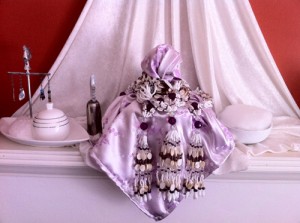
Obatala Obamoro’s shrine draped in light lavender cloth with Oke on the right and Agidai on the left
Orisha: Obatalá
Saint: Our Lady of Mercy
Colors: White
Number: 8
Description: Obatala is the eldest of the Orishas, the owner of white cloth, the king of peace and logic. He encourages us to use diplomacy and reason when acting and is often the Orisha who mediates disputes between the other orishas. Obatalá is actually a androgynous Orisha where half of his avatars are male and the other half are female. It is therefore possible to have a female Obatalá like the road Obanlá in addition to male roads like Ayáguna. Obatalá’s shrine is placed higher than the other Orishas‘ shrines out of respect for his status as their elder. He is often depicted as an elderly black man with chalk white hair dressed in white robes.
Orisha: Obba
Saint: Saint Catherine of Siena
Colors: Brown, opal and coral
Number: 8
Description: Obba is the Orisha of marriage and personal transformation. She was Shangó’s legitimate wife who was shunned after trying to ensnare Shangó with witchcraft. She fled to the cemetery and underwent a powerful transformational journey that made her come into her true power. She is depicted as a homely woman, missing her left ear, wearing a headwrap to cover her wound.
Orisha: Oyá (Yansa, Yansan)
Saint: Our Lady of Candelmas or Saint Theresa
Colors: Brown, dark red or multi-colors
Number: 9
Description: Oyá is a fierce female warrior and the Orisha of change. She took the secret of slinging lightning from Changó. She fights with machetes and scares away Ikú (death) with her horsetail fly whisk. She is the owner of the cemetery gates, but does not live in the cemetery contrary to common belief. She resides in the marketplace. She is depicted as a lithe powerful warrior woman wearing a skirt of nine different colors.
Orisha: Yeguá (Yewá)
Saint: Our Lady of Montserrat
Colors: Pink and burgundy
Number: 7 or 9
Description: Yeguá is Oduduwa’s special daughter who he was keeping as a symbol of purity and chastity. Unfortunately her purity was tainted when she was violated by Changó. She is the Orisha associated with death as she rules the decomposition of the body in the grave and the mysteries associated with the dying process. She is depicted as a mysterious woman, withdrawn from society residing in the bottom of a grave.
- Orisha: Aggayú (Agajú, Aganyu, Aggayu Sola)
Saint: Saint Christopher
Colors: Brown and opal
Number: 9
Description: Aggayú is Shangó’s father in Santería. Some godfamilies say he is Shangó’s younger brother, but they are related to one another in every instance. Aggayú is the orisha of the volcano and the ferryman who takes people back and forth across the river. Some lineages refer to him as the Orisha of the desert. His worship is closely aligned with that of Shangó. He is depicted as a stocky built man who walks with huge strides and carries a double headed axe with a curved double handle.

Oshun by Carla Nickerson
- Orisha: Ochún (Oshún)
Saint: Our Lady of Charity of Cobre
Colors: Yellow and amber
Number: 5
Description: Oshún is the Orisha of sweetness, love and beauty. She is the embodiment of feminine grace, and is a flirtatious coquette. She is a generous and loving mother, but she can also quickly turn bitter if she is wronged. Once she is soured, she is unforgiving and unbending. Oshún can accomplish miracles untold. She is the youngest of the orishas and is depicted as a flirtatious, mixed-race woman dressed in yellow, gazing in a mirror.
Orisha: Yemayá (Yemoja)
Saint: Our Lady of Regla
Colors: Blue and clear
Number: 7
Description: Yemayá is the mother of all living things, the queen of heaven, earth and all waters. She resides in the ocean and her children are countless like the fishes in the sea. Yemaya is the mother of many of the other Orishas as well. In addition to being a loving mother she is a fierce protectress. She can fight with a machete or a scimitar and bathe in the blood of her enemies. Yemaya is often depicted as a voluptuous black woman with full breasts dressed in blue.
Orisha: Shangó (Changó, Sango)
Saint: Saint Barbara
Colors: Red and white
Number: 6
Description: Shangó (Changó) is the king of the religion of Santería and was once the fourth king (Alafin) of the city of Oyó in Yoruba land before he was deified and became an Orisha. He is the Orisha of lightning, thunder and fire, the owner of the sacred batá drums, the power of passion and virility. Changó is a ladies’ man and a charmer. Changó is the master of dance, a fierce warrior and a powerful sorcerer who spits fire. He is depicted as a handsome, young man wearing a crown and carrying a double headed axe.
Orisha: Orunmila (Orunla, Orula)
Saint: Saint Francis of Assisi
Colors: Yellow and green (or brown and green)
Number: 16
Description: Orunmila is the Orisha of divination and the patron of the Ifá sect. He along with Elegguá witnessed all of destiny unfold and therefore can be consulted to know where a person’s fate is headed. He developed the oracles of Ifá: the ikines (palm nuts) and the okuele (diviner’s chain). His priests are known as Babalawos and function exclusively as diviners. They do not ordain people into the mysteries of orishas other than Orunmila. He is depicted as a wizened black man with graying hair, dressed in traditional African garb carrying his wooden diviner’s tray.

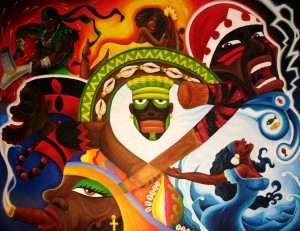
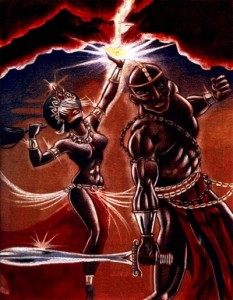
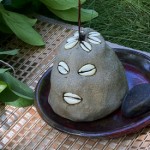
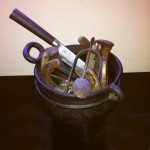
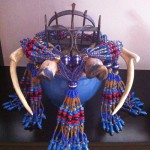
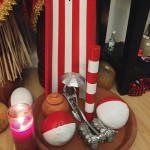
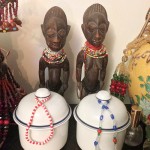
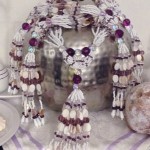
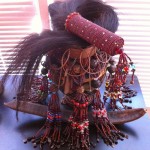
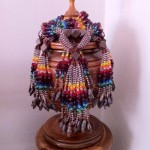
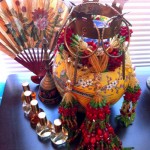
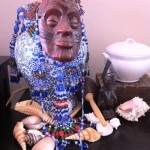
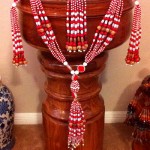
 Pagan Blog Project
Pagan Blog Project
Follow Us!